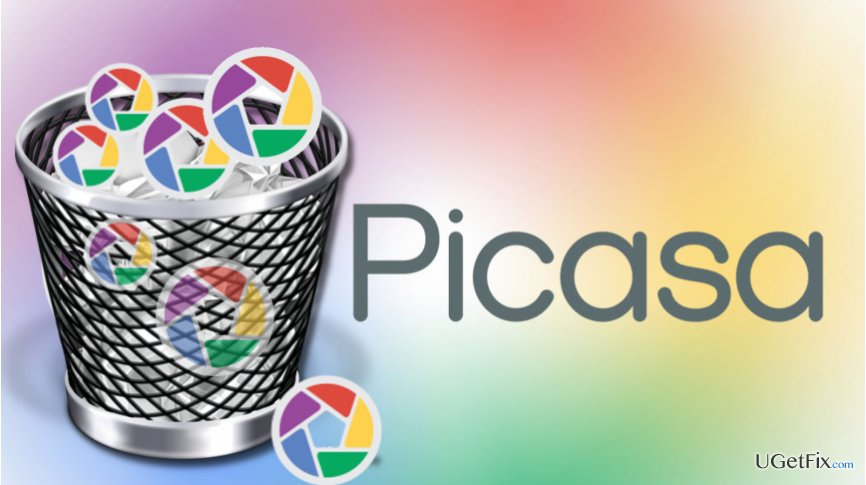Question
Issue: How to Uninstall Picasa?
I‘ve read about Picasa‘s retirement just now. I‘ve saved all important pictures stored on Picasa Albums and can now delete it. Please tell me if it‘s removal has to be performed somehow differently?
Solved Answer
Picasa is an image viewer and organizer utility, which allows people editing and sharing digital photos. It has been developed in 2002 by a company known as Lifescape and redeemed by Google in 2004. Up till then, Picasa has been offered to both Windows and Mac OS X users as a freeware. However, Picasa did not perform as an installed app only. People could have upload pictures to photos.google.com or Picasa Web Album and see all the content in Google Photos account. If you‘ve been using Picasa‘s services, there‘s no need to expediate on its services, advantages or disadvatages. The more important is th fact that Google has retired Picasa in March, 2017, which is why there‘s no point of keeping the app installed.
Google retired Picasa to focus on Google Photos
„Picasa is now retired.“ That‘s a fact officially announced by Google in the spring of 2016. Picasa and Picasa Web Album service started to be discontinued more than a year ago. For now, Google is focusing on Google Photos, which offers a more advanced photo sharing and storage service. Therefore, if Picasa app is still running on your PC, we recommend you to uninstall it and switch to another photo viewing, storing, and sharing utility. If you wonder what‘s the fate of photos that are still stored on your Picasa Web Album, please refer to this post and find out all the necessary information.

Uninstalling Picasa
Windows OS
- Press Ctrl + Alt + Del to Open Task Manager.
- Locate Picasa, click it, and select End Task.
- Right-click on Windows key and open Control Panel.
- Open Programs & Features and find Picasa.
- Click it and opt for Uninstall option.
- Follow the on-screen instructions and the click Remove on the confirmation pop-up.
- Once done, press Windows key + R, type regedit, and press Enter.
- Click Edit at the top of the Registry Editor window and select Find.
- Type Picasa and wait while the search results are being prepared.
- If any Picasa leftovers are found, delete all of them.
- Finally, reboot your PC.
Mac OS X
- Press Cmd +Opt + Esc, select Picasa and click Force Quit.
- Then navigate to the Utilities folder and open Activity Monitor.
- Select All Processes and look for processes related to Picasa.
- Click on them and select Quit Processes icon.
- After that, log into Mac with an administrator account.
- Open Applications folder and search for Picasa.
- Click it, hold, and drag it to the Trash folder.
- After that, check the Preferences folder within ~/Library/Preferences, ~/Library/Application Support/ or /Library/Application Support/ and delete all Picasa‘s leftovers.
- Additionally, check /Library/Caches/ folder because it may also contain some files associated with Picasa.
- Finally, right-click on the Trash icon and select Empty Trash.
TIP: to ensure complete Picasa removal, we would recommend using software removal utility both for Windows and Mac OS X users. You can Perfect Uninstaller for cleaning up Windows and MacKeeper for Mac OS X. These programs will delete all software leftovers thus preventing the system from being clogged.
Get rid of programs with only one click
You can uninstall this program with the help of the step-by-step guide presented to you by ugetfix.com experts. To save your time, we have also selected tools that will help you carry out this task automatically. If you are in a hurry or if you feel that you are not experienced enough to uninstall the program by your own, feel free to use these solutions:
Access geo-restricted video content with a VPN
Private Internet Access is a VPN that can prevent your Internet Service Provider, the government, and third-parties from tracking your online and allow you to stay completely anonymous. The software provides dedicated servers for torrenting and streaming, ensuring optimal performance and not slowing you down. You can also bypass geo-restrictions and view such services as Netflix, BBC, Disney+, and other popular streaming services without limitations, regardless of where you are.
Don’t pay ransomware authors – use alternative data recovery options
Malware attacks, particularly ransomware, are by far the biggest danger to your pictures, videos, work, or school files. Since cybercriminals use a robust encryption algorithm to lock data, it can no longer be used until a ransom in bitcoin is paid. Instead of paying hackers, you should first try to use alternative recovery methods that could help you to retrieve at least some portion of the lost data. Otherwise, you could also lose your money, along with the files. One of the best tools that could restore at least some of the encrypted files – Data Recovery Pro.



